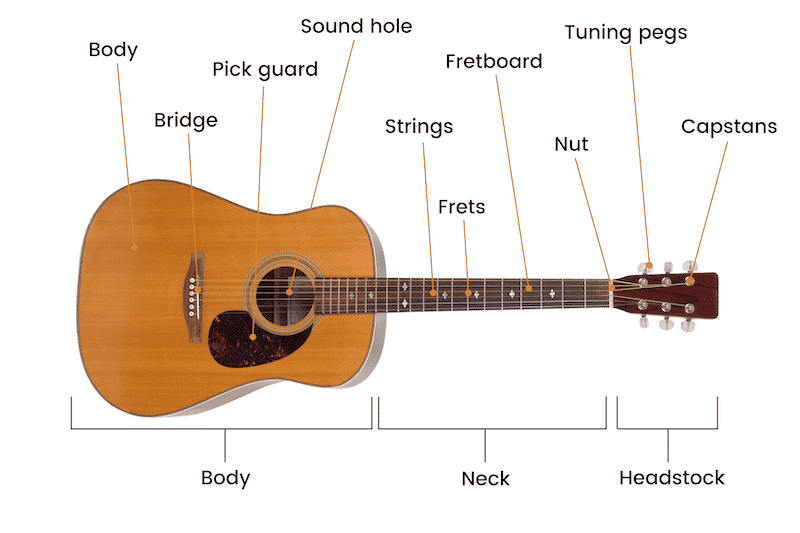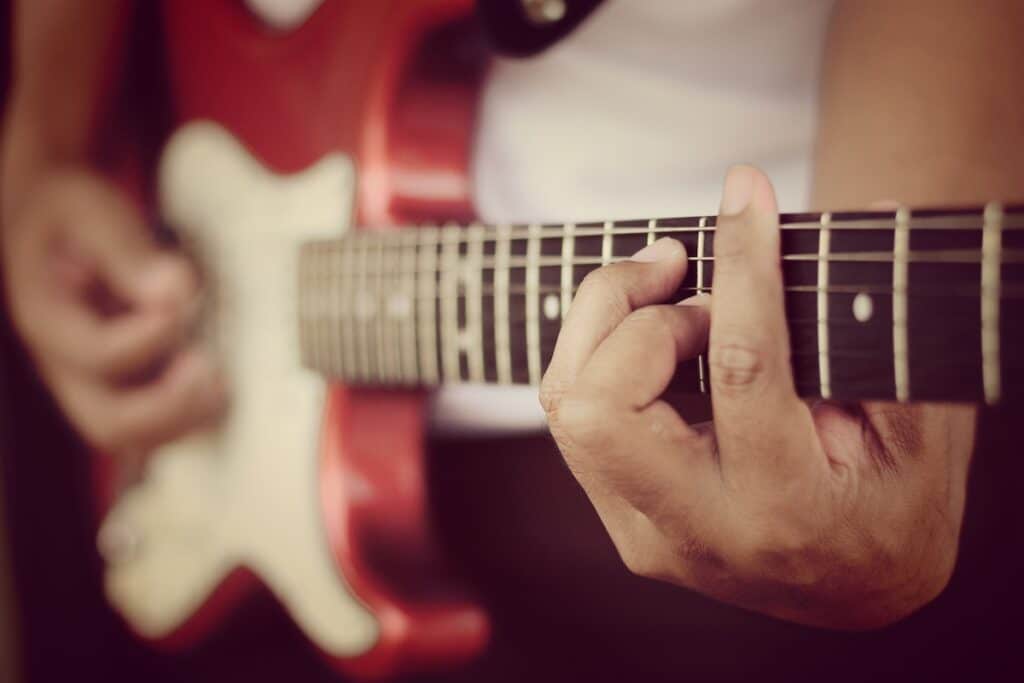Have you always wanted to learn the guitar but never know where to start? You’re not alone. Learning guitar can seem daunting at first, but with the right guidance and a step-by-step approach, you’ll be strumming your favorite tunes in no time.
We’ve put together the ultimate guide on how to learn guitar for beginners, covering everything from choosing the right guitar to mastering basic chords and developing a consistent practice routine. Ready to embark on your guitar journey? Let’s get started!
1. Choosing The Right Guitar

First things first, we need to get you a guitar. Your learning experience is largely influenced by the guitar you choose, which should be comfortable and easy to play.
You’ll need to ask a few questions to find which one will be right for you — things like how big you are, your hand size, and a number of other factors.
Remember, guitar teachers and free guitar lessons can only do so much; it’s the instrument in your hands that’ll make or break your progress.
Acoustic Vs. Electric
When it comes to guitars, there are two main types that can rock your world: acoustic and electric. The acoustic guitar is often recommended for beginners due to its simplicity and ease of use. They create their sound naturally through a hollow body, making them larger than their electric counterparts.
Electric guitars, on the other hand, offer more versatility and are perfect for rocking out. They have a solid body and create their sound electronically. However, they require additional equipment, such as an amp, leads, and pedals, to really get the most out of them.
So, when choosing between an acoustic or electric guitar, think about the music you want to play and the sound you want to create.
Budget And Quality
Once you’ve decided on the type of guitar, it’s essential to find one that fits your budget while offering good quality. Aiming for the perfect guitar means considering factors such as the materials used and the brand.
Ideally, you should not spend less than $150 on a beginner’s guitar. You can get some cheap knockoffs on Amazon, but they won’t last.
Here are some fantastic guitar brands to start your musical journey:
- Squier
- Yamaha
- Redwood
- Farida
- Ibanez
Before committing to a purchase, it’s best to head over to a guitar store and give your potential new companion a go, even if you later buy it online.
Trying out a guitar in person ensures you’re getting the one that’s perfect for you. Remember, your guitar journey is a personal one, and finding the right instrument will make all the difference.
Recommended reading:
- Our Favorite Acoustic Guitar Brands
- Our Favorite Electric Guitar Brands
- Quick Guide To The Different Types Of Guitar
2. Essential Equipment For Beginners
With your guitar in hand, the next step is to assemble the essential equipment that will enhance your playing experience. Beginner guitarists should invest in the following items:
- A guitar tuner to ensure your instrument is perfectly in tune
- A capo to explore different keys without changing chord shapes
- A guitar strap for comfort when playing standing up
- Picks to help you play more popular songs
- For electric guitar players, a cable and practice amp are needed to get a sound out of your instrument
These items will not only make learning to play more enjoyable but also help you build a solid foundation in guitar basics.
3. Understanding Guitar Anatomy

Next up, we have a quick lesson on the different parts of the guitar. Understanding the anatomy of your instrument is a key step towards becoming a proficient guitarist.
Familiarizing yourself with the different parts of both acoustic and electric guitars will help you better understand how they work and improve your playing technique.
The main components of a guitar include:
- The body
- The neck
- The headstock
- The fretboard
- The strings
Knowing the strings on your guitar will make your learning journey smoother and more enjoyable. The order of guitar strings is from the thickest to the thinnest: 6-1. This knowledge, combined with an understanding of the guitar’s neck and fretting hand positions, will help you play guitar notes with precision.
An electric guitar may also have various knobs and plugs that can enhance your playing experience.
4. Tuning Your Guitar

There’s nothing worse than an out-of-tune instrument. Period. For an enjoyable playing experience for yourself (and your audience), ensuring your guitar is well-tuned is vital.
The standard tuning for a guitar is EADGBE, referring to the six strings from low to high. Learning to tune your guitar accurately and quickly is an essential skill for any beginner guitarist.
Various types of guitar tuners can help you achieve the perfect pitch, including:
- Microphone-based tuners
- Vibration-based tuners
- Pedal tuners
- Smartphone apps
But starting out, you only need something simple that does the job. Anything like the below tuner will do you just fine.
- Compact, dual-hinged clip-on tuner
- Guitar, Bass, Ukulele, Violin and Chromatic tuning modes
- Color LCD screen with easy-to-read tuning needle
So whether you’re playing an acoustic or electric guitar, make sure to invest in a good tuner and keep your guitar sounding great.
5. Mastering Basic Chords

Learning to play guitar involves mastering basic chords as a vital step. Start with major and minor open chords, also known as cowboy chords. These simple guitar chords are the foundation for countless songs and will help you unlock the potential of understanding chord progression. As you practice, you’ll soon be able to play guitar chords with ease and confidence.
Practice proper finger placement and work on switching chords smoothly. Coordination between your right and left hand is essential for successful chord transitions. You can also use guitar chord charts to visualize how different chords are played.
As you get comfortable with basic chords, try learning more advanced chord shapes to expand your repertoire and play more complex songs.
6. Strumming Techniques

To play the guitar with ease and precision, it’s important to develop proper strumming techniques. Focus on rhythm, timing, and avoiding accidentally muting strings.
Good strumming technique starts with the right-hand movement, which should come primarily from the wrist, with the rest of the arm supporting when needed. The arm should be relaxed and rest against the body of the guitar for maximum comfort and accuracy.
To master your strumming technique, try to avoid muting strings accidentally and explore different up and downstrokes. Playing in time is essential for successful strumming, so use a metronome to help you stay in rhythm and master the timing of your notes. By practicing various strumming techniques, you’ll gain the confidence to play your favorite tunes with ease.
7. Reading Guitar Tab
Guitar tablature, or tab, is an easy way to understand music notation specifically designed for guitar. Instead of sheet music, tabs show you exactly where to place your fingers on the fretboard, making it simple to learn guitar chords, melodies, and riffs.
Tabs display horizontal lines representing the strings of a guitar and numbers indicating the frets where you should place your fingers. Open strings are denoted by zero (0). Muted strings, on the other hand, are represented with the letter X.
By learning to read guitar tablature, you can easily play chords, slides, bends, hammer-ons, pull-offs, and more, making the learning process more enjoyable and efficient.
8. Picking Techniques And Using A Pick

Picking techniques are essential for playing individual notes and intricate melodies on both acoustic and electric guitars. To improve your picking techniques, learn how to properly hold and use a guitar pick.
Grip the pick between your thumb and index finger, keeping the other three fingers free. Hold the pick so that its edge protrudes from the side of your thumb. Make sure your thumb’s nail is facing you. Start slowly and gradually increase your speed, picking both up and down.
Beginning guitarists should choose a pick of medium thickness (between .72mm and .88mm) for optimal results. As you progress, you may experiment with different pick thicknesses and materials to find the one that best suits your playing style.
Mastering your pick technique will enhance your overall experience with the instrument and open up new possibilities in your guitar playing.
9. Scales And Finger Exercises
Increase your dexterity, finger strength, and overall playing ability by practicing scales and finger exercises on your playing guitar. Scales help you explore the guitar fretboard and discover the different notes available, while finger exercises build muscle memory and improve coordination between your fretting hand and picking hand.
Start by learning major and minor scales and play them up and down the fretboard. Commit the scales to memory and practice them regularly to build speed and accuracy. Incorporate finger exercises into your practice routine to improve your finger independence and prepare you for more advanced techniques.
As you gain proficiency in your scales and finger exercises, you’ll notice a significant improvement in your overall playing ability.
10. Playing Your Favorite Songs
One of the most enjoyable aspects of learning guitar is playing your favorite songs. This not only makes practice more fun but also helps motivate you to keep improving. To learn and play your favorite songs, use guitar tabs or interactive apps, such as Yousician or Melodiq. These resources make it easy to access song chords, lyrics, and tablature, allowing you to play along with your favorite tracks.
As you progress in your guitar journey, you’ll find that playing songs helps you develop a better understanding of chord progressions and song structures. This knowledge will eventually enable you to create your own songs and play with other musicians across various musical genres. So dive into your favorite tunes and start playing them on your guitar!
11. Developing A Practice Routine
To improve your guitar skills and build muscle memory, establishing a consistent practice routine is fundamental. Here are some tips to help you:
- Dedicate time each day to practicing, even if it’s just for a few minutes.
- Aim for at least half an hour of practice each day, but remember that even short sessions on busy days are better than nothing.
- Consistency is crucial when it comes to learning guitar, so make practice a priority.
Incorporate the following into your practice routine:
- Warm-ups
- Scales
- Finger exercises
- Chords
- Songs
Playing with other people can also be a great way to pick up skills and explore your creative side. As you progress, remember to challenge yourself with new techniques and more complex songs to keep your practice sessions engaging and enjoyable.
12. Finding A Guitar Teacher Or Course
Despite the abundance of free online resources for learning guitar, it could be beneficial to find a guitar teacher or enroll in a course for a more personalized and structured learning experience. A guitar teacher can provide valuable feedback, help you avoid bad habits, and tailor lessons to your unique learning style and goals.
There are also numerous online guitar lessons and courses available, such as:
- Guitar Tricks (Free Trial)
- TrueFire ($100 Off with Coupon Code: HelloMusicTheory100)
- Artist Works
These platforms offer a wealth of lessons, covering everything from guitar basics to advanced techniques and music theory. By investing in a guitar teacher or course, you’ll receive the support and guidance needed to learn to play guitar efficiently and effectively.
Disclaimer: Some of the links above may be affiliate links, which means HelloMusicTheory may get a commission if you purchase at no additional cost to you.
Summary
Learning guitar can be an exciting and rewarding journey. By following this step-by-step guide for beginners, you’ll be well on your way to mastering the instrument and playing your favorite songs.
Remember to choose the right guitar, invest in essential equipment, understand guitar anatomy, and develop good practice habits. Incorporate scales and finger exercises into your routine, learn to read guitar tablature, and explore various strumming and picking techniques. Finally, consider finding a guitar teacher or enrolling in a course for personalized guidance and structured learning.
With dedication and consistent practice, you’ll see significant progress in your guitar-playing abilities. Embrace the challenge, enjoy the learning process, and, most importantly, have fun on your guitar journey!
Frequently Asked Questions
How can I teach myself to play guitar?
Start by reading as much as you can about guitars and create a learning environment that is comfortable for you. Then, learn the basic chords perfectly and build skills by learning songs or try to pick up songs by ear. Lastly, practice often and be patient with yourself as you teach yourself to play guitar.
How should beginners learn guitar?
Start by learning simple chords, practicing regularly, and being patient with yourself. Pick up songs by ear, join a community of other new players, and find the best guitar for you to create an ideal learning environment.
What’s the best type of guitar for a beginner?
If you’re a beginner, starting out with an acoustic guitar is the best way to go. It’s simple and straightforward yet still offers plenty of versatility. Electric guitars provide more range and can be tailored to certain music genres, making them a great option as well.
How often should I practice guitar?
Make sure to practice guitar for at least half an hour each day — consistency is key for learning guitar, and even short practice sessions are better than none.
How can I improve my strumming technique?
Focus on your rhythm and timing, practice various up- and downstrokes, and use a metronome to stay in rhythm. This will help you avoid accidentally muting strings and improve your strumming technique.

